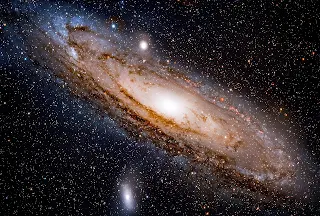NOT AS IT IS BUT AS IT WAS
Usain Bolt currently holds the world record for being the fastest man on the planet. In the 2009 IAAF World Champions, Bolt reached his all-time top speed of 44.72 km/h, completing the 100 m sprint event in 9.58 seconds. The fastest humans have ever flown was during the Apollo 10 mission in 1969, when the re-entering spacecraft reached a breakneck speed of 39,897 km/h. For comparison, Earth revolves around the Sun at about 108,000 km/h, which in turn, orbits the galactic centre at 720,000 km/h, and not to mention that the Milky Way is itself cruising through 2.1 million km of intergalactic space in under an hour.
No matter how intimidating these numbers seem, yet nothing can move faster than that of light, cruising at the rate of 300,000 km/s or 1,080,000,000 (more than a billion) km/h. It is tempting indeed to think that why not travel faster than light, at infinite speeds, so that motion becomes instantaneous? However, from Einstein's theory of special relativity, we not only learn that infinite speeds or instantaneous travel are a theoretical absurdity, but the speed of light imposes a universal limit to how fast an object can move. Einstein's special relativity tells us that the speed of light is a fundamental constant, a rigid parameter and an immutable property of our universe, which helps shape our reality as we know it. It preserves the act of causality and prevents us from killing our grandfather for whatever reasons we want to kill him. Nothing and almost nothing in our universe can exceed this speed limit.
When it comes to high-speed travel, we have certain physical and mostly technological limitations. Our fastest trains can only go as high as 550-600 km/h, while our best cars can top 430 km/h. Our fastest commercial aeroplane, the Concorde, had recorded a supersonic speed of 2,179 km/h (~ Mach 2), while the fastest military aircraft, the Lockheed SR-71 Blackbird, settled with a score of 3,540 km/h (~ Mach 3). A light beam or a light photon is chiefly a travelling bundle of electromagnetic energy, cruising through the vacuum of space at the blistering rate of 299,792.458 km/s. It is merely human of us to speculate about objects travelling at infinite speeds. However, the laws of physics tell us that even Nature has Her limitations, one such being the speed of light. To understand why this particular number (denoted by c) is such a rigid constant, we need a good understanding of Newton's laws of motion, his concept of space and time, the underlying flaws and inconsistencies within the Newtonian framework, the covariance of Maxwell's laws and the eventual rise of the special relativity, all of which deviates considerably from our current course of discussion. But for now, let us bear in mind that for superluminal (i.e., faster-than-light) travel, we require an inconceivably large force and infinite energy to propel something beyond c. Such a scenario is in no way permissible by the known laws of physics. Albeit light can slow down while travelling through a transparent media like glass, water or air, but in the vacuum of space, it will move exactly at the rate of 299,792.458 km/s and none the other. Had the speed of light been something else, then the universe might not have existed in the first place or could have been entirely different.
 |
| A beam of sunlight Image Credits: Photo by form PxHere |
Our day-to-day experience makes us think that light travels instantaneously. And why not? Whenever we enter a dark room and turn on our lights, we see the room uniformly illuminated before we even have the time to blink. Let us now perform a simple experiment. All we need to do is find ourselves an incandescent bulb and stare at it with our undivided attention. Now let us hit the switch, turn it off, and again turn it on and repeat this a number of times. Upon repeatedly performing the experiment, we conclude that light takes almost no time to radiate from the source and enter our eyes. It seems that light has travelled in an instant. In fact, there is no ordinary way of knowing if light travels instantaneously or with an exceedingly high speed. If someone thinks hard enough, he might come up with a third possibility, that light travels incredibly fast, faster than our eyes can detect. Centuries ago, a Greek philosopher, Empedocles, was the one who thought of the third possibility. He proposed that light is a thing that travels from one place to another with a finite speed, and being a thing in motion, it must take some time to move from here to there. But at that time, no one was willing to accept Empedocles' strange idea against Aristotle's notion of light being instantaneous. They were not wrong to outright reject such a possibility. As per our human perspectives, light moves so incredibly fast that it took almost 2000 years since Empedocles to make a first attempt at measuring the speed of light. Even then, it took a couple of centuries more to arrive at the present accepted value of the speed of light.
If light travels at a finite speed, it has to incur some time delay while it goes from here to there. Suppose, if we turn on a bulb, say one km apart, we would have to wait for some time for the light to cross this distance of 1 km before reaching our eyes. By measuring the waiting period, it would be fairly easy to determine the speed of light. Based on this line of thought, somewhere along the mid-1600s, Galileo allegedly set up an experiment to determine the speed of light. What he did can be described as follows. He bought a pair of covered lanterns, and giving one to this assistant stationed at the top of a hill, told him to uncover the lamp as soon as he saw the flash from Galileo's uncovered lantern. Galileo himself stood on a hill a mile away. According to his understanding, if light travelled at a finite speed, it would take some time for the light beam emitted from his lantern to reach the eyes of his assistant, who would then uncover his lamp for Galileo to receive the returning flash. And in this two-way travel, Galileo expected to measure the time delay and hence determine the speed of light. Unfortunately, Galileo had grossly underestimated the speed of light. Travelling at 300,000 km/s, considering Galileo's experiment, light would only encounter a time delay of 11 microseconds (a millionth of a second) over its two-way path. In those days, no clock had been invented to measure such a small interval. Even though Galileo's experiment yielded a null result, he was clever enough to conclude that light must be at least ten times faster than sound, for sound travelling at the speed of 343 m/s would encounter a time delay of about 9 seconds in this experiment.
Let us now think of a different scenario. Suppose you station your friend on the Moon with a very powerful flashlight. Before sending him away, you instruct him to switch on his flashlight as soon as he sees you flash. As per Galileo's experiment, there is going to be some time before you see your friend's flash. When you turn on your flashlight, you simultaneously start your stopwatch and wait to hit it as soon as you see your friend's flash. Neglecting your reaction time, you find that the total time delay amounts to 2.6 seconds. Knowing the Earth-Moon distance to be 384,400 km on average and the 2.6 seconds two-way time delay, you get a value nearly close to 299,792.458 km/s as the speed of light. Had light travelled instantaneously, there would have been no time delay whatsoever. But because of its finite speed, it takes about 1.3 seconds to cover the Earth-Moon distance to reach your friend's eyes, wherefore, the second beam needs another 1.3 seconds to return to you, thus amounting to the recorded delay of 2.6 seconds.
This time delay becomes increasingly significant over extremely large distances. Suppose, in the above thought experiment, instead of flashlights, you give your friend a cell phone. Radio waves are also electromagnetic radiations travelling at c. Now you pick up our phone, dial his (your friend's) number and wait for him to pick up and say hello. The moment you hear your friend, you reply with a hello and simultaneously start your stopwatch to record the time it takes to pick up the second hello. As expected, the total time delay amounts to 2.6 seconds.
 |
| We are always seeing the Moon the way it was 1.3 seconds ago Image Credits: Photo by form PxHere |
At this point, we should define something called light travel time. Light travel time is the time taken by light to travel a fixed distance. Since the speed of light is 299,792.458 km/s, in one second, light travels a distance of 299,792.458 km. Instead of saying that light takes about 1.3 seconds to travel from Earth to the Moon, we can equivalently say that the Moon is 1.3 light seconds away. If we were to travel at the speed of light (in an imaginary spaceship) then it would take a mere 1.3 seconds to have a touchdown on the lunar surface. Similarly, the Sun, situated about 150 million km from Earth, is only 8.5 light minutes away from us. This is where things get interesting.
The finite speed of light destroys our sense of now. The concept of the present moment or the phrase, 'living in the moment' starts to lose its definite meaning. There seems to be no apparent universal now, but all is relative. Someone's present moment becomes another's past. This can be understood as follows. When we say that the Moon is 1.3 seconds away, we mean that a light signal or an information signal will require 1.3 seconds to reach there. Just like that, a signal sent from the Moon will take an equal 1.3 seconds to get to Earth. So whenever we turn our eyes towards the Moon, we are seeing it not like the way it is right now, say at around 19:15:36.45 local time, but the way it looked 1.3 seconds earlier, i.e., when our clock read 19:15:35.15. The Moon shines by reflecting sunlight off its surface and this reflected light is always going to take 1.3 seconds to reach us. So to see the Moon right now, i.e., when our clock reads 19:15:36.45, we need to wait for 1.3 seconds till 19:15:37.75 because the reflected light that has bounced off now (i.e., at 19:15:36.45) is going to take 1.3 seconds to cover the Moon-Earth distance of 384,400 km.
 |
| How do we know that our Sun is okay? We wait for 8.5 minutes. Image Credits: Photo by form PxHere |
Similarly, when we look at the Sun, we see it as it was 8.5 minutes ago. If we want to know how it looks right now, we have to wait for 8.5 minutes as the photon leaving the Sun's surface (right now) has to travel this 150 million km Sun-Earth distance before reaching our eyes. Going down the rabbit hole, if the Sun were to disappear (as you read this article) all of a sudden, we are not going to realise anything until 8.5 minutes have elapsed. And by the time the news of the Sun's disappearance, a sudden absence of light and a pitch-black sky in the middle of the day reaches us, the Sun would be long gone. It would have become a past event. Even though we will say that the Sun disappeared at 14:13 hours, the actual event happened 8.5 minutes prior and we simply did not know that.
As already mentioned, this time delay worsens with increasing distance. Imagine having a friend on the Sun. In order to establish a two-way communication, both parties would be waiting for 17 minutes to hear from each other. This inherent delay in communication exists on Earth also. But because the separation between two people on the surface can not be more than 40,000 km on average (the polar or the equatorial circumference), the total time delay is about 266 milliseconds (1000th of a second) which is too small to be detected by our senses. If your friend is 1 mile apart (like in Galileo's experiment) then every time you hear a hello from him, the signal has been delayed by 11 microseconds. Even now, whoever is reading this article, on their phones, laptops or desktop computers, there is a time delay of a few nanoseconds.
We always get a feel of seeing everything in real-time, but where is our now, as in the present moment? The finite speed of light sets a limit to the speed of all information. We are always reeving delayed information. Even though in our day to day lives, this time delay is only of the order of a few milliseconds to nanoseconds, but nevertheless, it is still a delay. It is virtually impossible to eliminate this time delay.
 |
| It is all in the past Image Credits: Photo by form PxHere |
Whenever we are looking at the star-filled night sky, the Milky Way and the known constellations we are seeing everything the way it was millions and billions of years earlier. Take Jupiter for example. As of now, from the data provided by Stellarium, Jupiter is about 628 million km or 34.8 light minutes away from Earth. So when we turn our eyes towards the mighty planet, we are receiving the reflected light which bounced off from the gas giant's upper atmosphere 34.8 minutes ago. A similar thing happens for Mars which is about 8.72 light minutes away right now. Saturn is about 73.6 light minutes or about an hour and 13 minutes away from Earth. So if we are to look at Saturn right now, we would be seeing our ringed planet the way it was 73 minutes ago. If something dramatic happens to it right now, there is no way we are going to know anything about it until 73 minutes have elapsed. To make things worse, Pluto is almost 5 hours out. So if you are looking at Pluto at say 21:00 hours, you are actually seeing the planet the way it was at 16:00 hours.
This is why it is oftentimes said that a telescope is much of a time machine, but instead of taking us forward in time, it shows us the past. And because of this finite speed, we get to see the universe the way it looked a few million years after the big bang. Take Betelgeuse, for example. The bright star that forms Orion's shoulder is about 640 light years, i.e., about 6 thousand trillion km or six quadrillion km away from us. The orange-red light we are receiving today left the star's surface 640 years ago! Betelgeuse is a red giant star set to explode in a supernova any day within the next 100,000 years. Even if Betelgeuse explodes right now, we will know nothing about it until this day of the year 2662. It is equally possible that Betelgeuse has already exploded, but due to the finite speed of light, there is no way the information will reach us any sooner.
 |
| How do you look now? The Andromeda galaxy as it was 2.5 million years ago. Image Credits: via Wikimedia Commons |
Alpha Centauri, the brightest star in the southern constellation of Centaurus, is about 4.3 light years away from us. This means we see the star as it was 4.3 years ago, where one light year is the distance travelled by light in one year, which amounts to about 9.5 trillion km. A two-way communication is going to last for nearly nine years. It is better not to have such long-distance friendships as it is nowhere practical to sit by your phone for such a long time.
Milky Way's galactic neighbour, the Andromeda Galaxy, is 2.5 million light years away from earth. So the light reaching us today left its galaxy 2.5 million years, i.e., when our distant tree-dwelling prehistoric ancestors were trying to leave some footprints on the moist African soil. If some supernova explodes in Andromeda right now, we will know nothing about it unless 2.5 million years pass on earth, and by that time, most of humanity would have migrated to another star system. Our galactic centre is about 26,000 light years away from us. So when we are looking at the supermassive black hole at the centre of the Milky Way, we see it the way it appeared 26,000 years ago. There are far more distant stuff in our universe. The oldest quasars and galaxies are 13.1 billion years old, whereas our universe is itself 13.8 billion years old. So the light of the distant quasars left at a time when the universe was only 700 million years old, and in all this time, it has been travelling through the vastness of intergalactic space only to be picked up by our telescopes.
References:
- https://www.scienceabc.com/innovation/how-did-we-measure-the-speed-of-light.html
- https://www.space.com/15830-light-speed.html
- https://www.wired.com/2016/01/how-to-measure-the-speed-of-light-with-lanterns-wheels-and-planets/
- https://en.wikipedia.org/wiki/Earth%E2%80%93Moon%E2%80%93Earth_communication#:~:text=Propagation%20time%20to%20the%20Moon,the%20Moon%20is%20384%2C400%20km).
- https://www.sciencedaily.com/releases/2017/06/170621145130.htm
- https://phys.org/news/2018-12-when-you-look-up-how.html
- https://www.sciencealert.com/simple-animations-by-a-nasa-scientist-prove-the-speed-of-light-is-torturously-slow
- http://www.philosophy-of-physics.ox.ac.uk/2013/10/16/the-speed-of-light/#:~:text=Aristotle%20wrongly%20contended%20that%20the,it's%20186%2C000%20miles%20per%20second.


Comments
Post a Comment